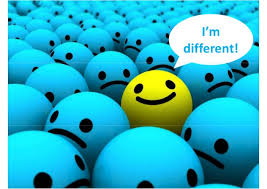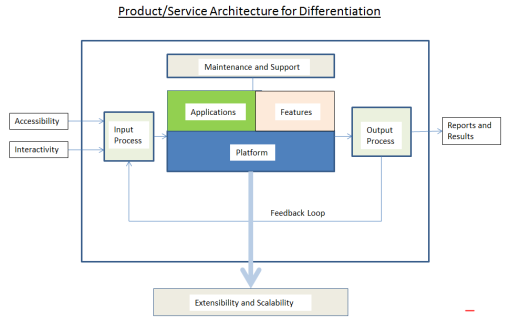 This is a particularly interesting subject as we, investors, think about investing in a company. And while this blog is directed to those potential entrepreneurs, the ideas suggested in this blog are equally applicable to new products and services developed by a business to increase their revenue, replace existing products/services, or compete in the market.
This is a particularly interesting subject as we, investors, think about investing in a company. And while this blog is directed to those potential entrepreneurs, the ideas suggested in this blog are equally applicable to new products and services developed by a business to increase their revenue, replace existing products/services, or compete in the market.
Many entrepreneurs – and investors alike- think that differentiation is based on the Intellectual Property underlying the product. That may be true if the IP is really unique. Yet, as one knows patent protection only goes so far. If a new smaller company has a patent that “infringes” on a larger company’s business, for example, the larger better financed company can sue for infringement and cause the smaller company to lose focus on their end game.
Differentiation can enable a company to create a moat around their business that would make it difficult for a competitor to penetrate. At best, it protects the company for the long term. At worse, it enables protection for a period of time so the new company can establish their brand and get first mover advantage. And, in the best case, the new company has such an advantage with their product that the larger company buys the smaller company for $1 billion or more and the founders feel pleased that they created a unicorn!!! (We can all dream, right?)
Differentiation can take place on several levels. The following diagram shows and input/output schematic for product/service differentiation. In the diagram, there are 11 different areas where differentiation can take place. The entrepreneur can focus on one or several of these areas keeping in mind that they are competing for a customer’s mind share relative to what either direct competitors can offer or other solutions that the customer may find acceptable. For example, when I was commercializing Wi-Fi on airplanes we initially thought that the competition was the on-board entertainment system. In fact, that was only one competitor; the other “competition” that competed for the customers’ attention included eating, sleeping or reading!! It was evident in the rear view mirror.

Differentiation can take place at one or several of the components of the product or service. In this diagram there are 11 different areas where the entrepreneur can focus. Most of the time, the focus is on the main platform or product and its features. Yet differentiation can take place in the following areas as well:
- Accessibility: How a customer finds the product or service. This includes channels of distribution, online, door to door, word of mouth and is part of the input process.
- Interactivity: Does the product or service require input from the customer? Is this input active requiring the customer to input information or is it more passive, with the input process providing the input by reaching out to other databases?
- Input process: Is there a unique way that the product or service uses the data to and integrates or converts the data into elements which can be acted upon by the platform?
- The platform: this is the core of the product and the essence of the technology. It is the engine to drive applications and features.
- Features: the specific features that provide benefits to the customer and are inherent in the platform.
- Applications: the specific uses for the product that the customer may or may not realize. These applications can be developed by the company or by partners.
- Maintenance and customer support: Is the product self-testing or do customers have to provide some input into testing and maintenance? Is customer support online only or a combination of online and human interaction? Maybe I am old-school, but occasionally I would like to speak with a human and the documentation and self-help guides are not necessarily very clear.
- Output process: What is the output process necessary to translate and provide an output to the customer? Can the output process be linked to another product or service from one of the company’s partners or another provider? For example, if the product/service is a new CRM system for the small business, can that system be integrated into a marketing automation or e-commerce system from Salesforce or Marketo?
- Reports and Results: This is what the customer actually sees as an output and is usable. Maybe this is a timeline, a report, a database, a social interaction, a picture or a posting, or even a data (Think of Match.com.)
In each of these elements, the entrepreneur has a few choices. We use the concept of PPT: people, process (automated), and technology to look at ways the element is enabled, used and managed. It is up to the entrepreneur how he/she wants to balance each of these three components because they will affect effectiveness and efficiency.
I want to point out one other way to differentiate and develop a moat for your company and product. In a book called Profit Zone, authors Adrian Slywotsky and David Morrison point out ways that a company can protect its profit and revenue stream. In developing and commercializing a new product the entrepreneur can think about the following elements as well. Strategic control points are normally industry specific yet we can general from most protective to least protective:
- Owning the standard through technology and IP
- Managing the value chain- including channels of distribution, input materials, shelf space etc.
- Developing a super dominant position by dint of their market share in specific markets, through specific channels, or with specific products. This is probably less likely for a start-up. Yet, perhaps the technology originated in a university and by dint of that they are super dominant in that market and want to expand beyond the university.
- Process including a unique way to provide information to a customer. Think Amazon
- People including the relationship of their customer support team to addressing issues. Think Nordstrom or Zappos.
- Own the customer relationship by focusing and understanding the unique preferences of a well-defined niche.
- Brand and trademarks. Think McDonalds, IBM, Google, Snapchat.
- Development lead time enabling the company to be first to market and build up first mover advantage.
- Cost advantage or cost parity enabling the company to compete should there be a price reaction from a competitor.
I trust this blog- perhaps a little lengthy- can provide some useful information for the budding entrepreneur and even those in corporate America engaged in developing and commercializing new products, services, or businesses. There is no easy answer; yet having a framework or two and breaking a complex problem into smaller manageable components can perhaps lead to success………. and the next unicorn.
You can hear and see entrepreneurs pitch their products at the TechCoastAngels Celebration of Entrepreneurship at the Segerstrom in Costa Mesa on March 10. Check out http://www.techcoastanagelscelebration.com to get tickets. Also, feel free to continue the dialog or contact David Friedman at dfriedman@clevelpartners.net or via phone at 949 4394503. Or retweet this to people who would like a good read.
Recent Comments